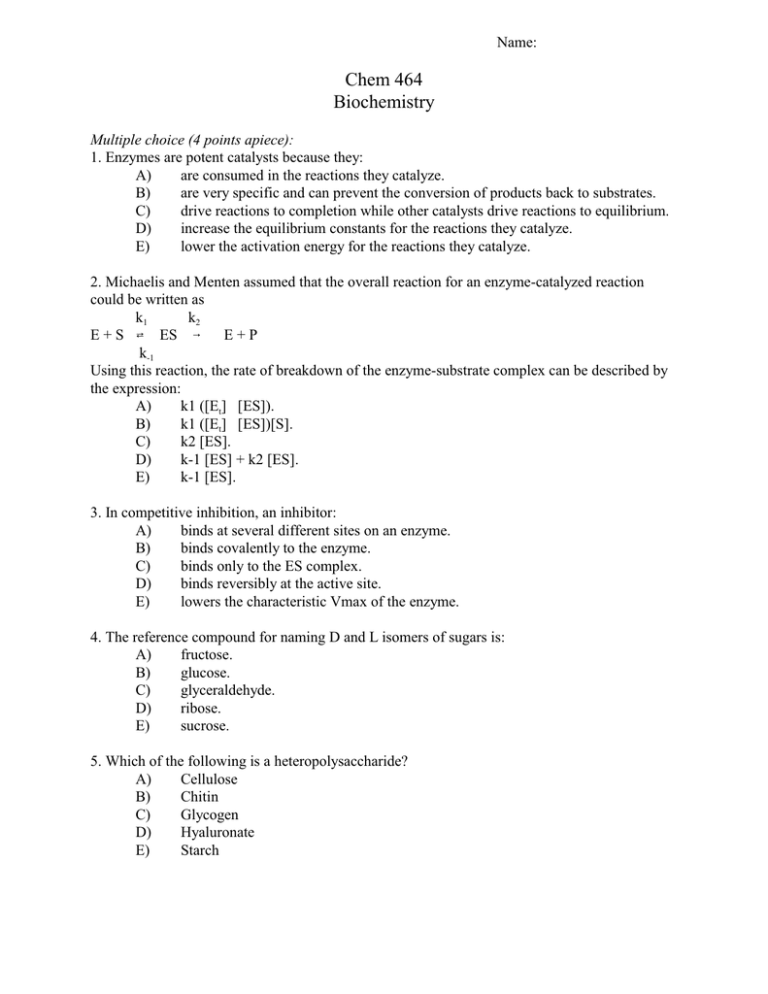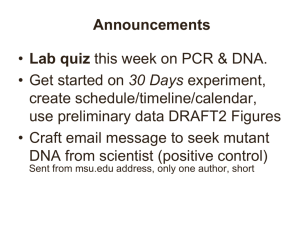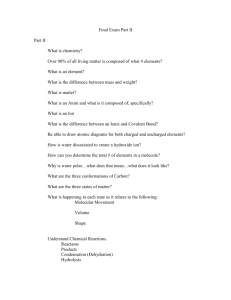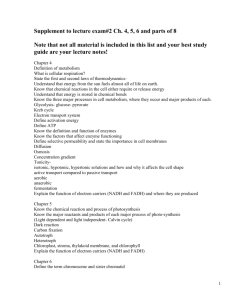Chem 464 Biochemistry
advertisement

Name: Chem 464 Biochemistry Multiple choice (4 points apiece): 1. Enzymes are potent catalysts because they: A) are consumed in the reactions they catalyze. B) are very specific and can prevent the conversion of products back to substrates. C) drive reactions to completion while other catalysts drive reactions to equilibrium. D) increase the equilibrium constants for the reactions they catalyze. E) lower the activation energy for the reactions they catalyze. 2. Michaelis and Menten assumed that the overall reaction for an enzyme-catalyzed reaction could be written as k1 k2 E + S W ES 6 E+P k-1 Using this reaction, the rate of breakdown of the enzyme-substrate complex can be described by the expression: A) k1 ([Et] [ES]). B) k1 ([Et] [ES])[S]. C) k2 [ES]. D) k-1 [ES] + k2 [ES]. E) k-1 [ES]. 3. In competitive inhibition, an inhibitor: A) binds at several different sites on an enzyme. B) binds covalently to the enzyme. C) binds only to the ES complex. D) binds reversibly at the active site. E) lowers the characteristic Vmax of the enzyme. 4. The reference compound for naming D and L isomers of sugars is: A) fructose. B) glucose. C) glyceraldehyde. D) ribose. E) sucrose. 5. Which of the following is a heteropolysaccharide? A) Cellulose B) Chitin C) Glycogen D) Hyaluronate E) Starch 2 6. For the oligoribonucleotide pACGUAC: A) the nucleotide at the 3' end has a phosphate at its 3' hydroxyl. B) the nucleotide at the 3' end is a purine. C) the nucleotide at the 5' end has a 5' hydroxyl. D) the nucleotide at the 5' end has a phosphate on its 5' hydroxyl. E) the nucleotide at the 5' end is a pyrimidine. 7. Compounds that generate nitrous acid (such as nitrites, nitrates, and nitrosamines) change DNA molecules by: A) breakage of phosphodiester bonds. B) deamination of bases. C) depurination. D) formation of thymine dimers. E) transformation of A T. Longer questions 10 points each 7. Inhibitors A. How does a competitive inhibitor work? B. How does an uncompetitive inhibitor work? C. How does a mixed inhibitor work? D. How does a suicide inhibitor work? 8. On the next page is a proposed mechanism for chymotrypsin. On that page point out the different kinds of catalysis that you see being used in this mechanism 3 4 9.Define the following terms: Aldose (ketose) puranose (furanose) epimer (anomer) proteoglycan (Glycoprotein) lectin 10. Name four different homopolysaccharides, For each homopolysaccharide name the monomeric sugar, the linkage used between the sugars, and say how what that homopolysaccharide is used for in nature. 11. Proteoglycans and Glycoproteins. A. (5 points) Where are proteoglycan normally found, and how does that compare to where glycoproteins are normally found? B. (5 points) Compare the structure of the carbohydrate in a proteoglycan to the structure of a carbohydrate in a glycoprotein. 12. Sketch the structure of pAp hydrogen bonded to pTp 13. Describe the structure of B-from DNA. 14A. (5 points) Chemically DNA is quite stable. However, in this class you discovered that there are certain chemical reaction that occur spontaneously that degrade DNA. Describe these reactions. How significant are they in a mammalian cell B. (5 points) There are also some environmental factors that can also degrade DNA. Describe soem of the things we find in the environment that can destroy DNA. 5 EDDCDDB






